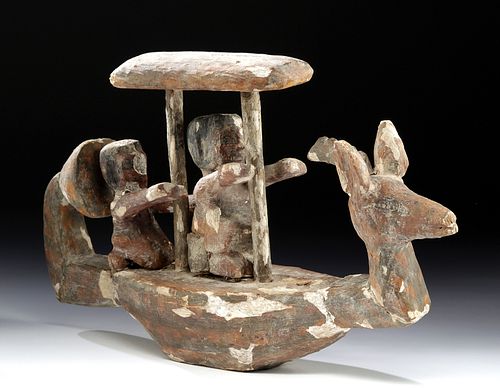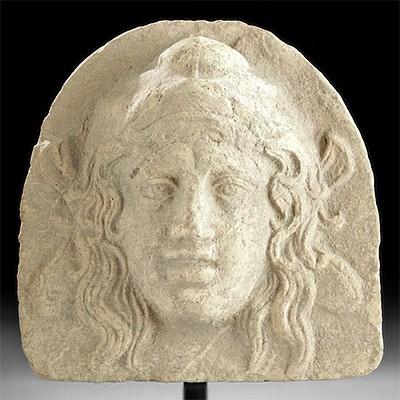Egyptian Wood/Painted Gesso Funerary Boat + Oarsmen
Lot 5
About Seller
Artemis Fine Arts
686 S Taylor Ave, Ste 106
Louisville, CO 80027
United States
Selling antiquities, ancient and ethnographic art online since 1993, Artemis Gallery specializes in Classical Antiquities (Egyptian, Greek, Roman, Near Eastern), Asian, Pre-Columbian, African / Tribal / Oceanographic art. Our extensive inventory includes pottery, stone, metal, wood, glass and textil...Read more
Categories
Estimate:
$6,000 - $8,000
Absentee vs Live bid
Two ways to bid:
- Leave a max absentee bid and the platform will bid on your behalf up to your maximum bid during the live auction.
- Bid live during the auction and your bids will be submitted real-time to the auctioneer.
Bid Increments
| Price | Bid Increment |
|---|---|
| $0 | $25 |
| $300 | $50 |
| $1,000 | $100 |
| $2,000 | $250 |
| $5,000 | $500 |
| $10,000 | $1,000 |
| $20,000 | $2,500 |
| $50,000 | $5,000 |
| $100,000 | $10,000 |
| $200,000 | $20,000 |
About Auction
By Artemis Fine Arts
Feb 27, 2020
Set Reminder
2020-02-27 10:00:00
2020-02-27 10:00:00
America/New_York
Bidsquare
Bidsquare : VARIETY SALE | Antiquities & Ethnographic Art
https://www.bidsquare.com/auctions/artemis-gallery/variety-sale-antiquities-ethnographic-art-4920
Around the world & back in time - be amazed at the treasures you will find. Antiquities from Egypt, Greece, Italy and the Near East, Asian, Pre-Columbian, African / Tribal / Oceanic, Native American, Spanish Colonial, Russian Icons, Fine Art, much more! Artemis Fine Arts info@artemisgallery.com
Around the world & back in time - be amazed at the treasures you will find. Antiquities from Egypt, Greece, Italy and the Near East, Asian, Pre-Columbian, African / Tribal / Oceanic, Native American, Spanish Colonial, Russian Icons, Fine Art, much more! Artemis Fine Arts info@artemisgallery.com
- Lot Description
Ancient Egypt, New Kingdom, 18th to 20th Dynasty, ca. 1549 to 1076 BCE. A finely preserved, hand-carved wooden model of a funerary boat with a tapered base, a flat top with a trio of narrow mortises, a frontal prow in the shape of a raised ibex head, a central canopy supported by a pair of columnar poles, and a back prow depicting a stylized lotus bloom. Two oarsmen, one kneeling and one seated, have petite tenons beneath their bodies that fasten within the mortises. The raised ibex head in front has a singular, serrated horn, a conical snout, and perky ears, with a dark scarab shown atop the canopy, and alternating red-and-orange frets along the boat body. Once carved, each component was covered in white gesso and painted with vibrant pigment in red, dark-brown, and orange hues. Model boats and boatmen like those in this example were created to be servants in the afterlife, ready to row the deceased upon the eternal Nile, as real boatmen would have done in the realm of the living. Size (boat): 16.375" L x 3.8" W x 9.3" H (41.6 cm x 9.7 cm x 23.6 cm).
The funerary boat - customarily decorated with red, white, yellow, orange, brown, and black as we see here - is a traditional Egyptian tomb offering created to symbolize the transport of a deceased individual from life to the afterlife. Scholars believe that the Egyptians envisioned death as a journey via boat across the River Nile - the sacred river which ran down the center of the country and was respected as a resource for agriculture, trade, transport, and a symbol of fertility. During the Sixth Dynasty, it became common to place wooden models of lifelike scenes in Egyptian tombs; by the Middle Kingdom, they were placed in the tomb chamber, around the coffin, although some very rich tombs had a separate chamber just for wooden models.
Two ships are found in almost all tombs that have models from this time period, and those ships are, during the Middle Kingdom, staffed by boatmen. According to the curatorial team at the MFA Boston, such funerary vessels were "made of papyrus bundles lashed together, transported the deceased either to a cemetery across the Nile or to the sanctuary of the god of the afterlife, Osiris, at Abydos. Models of such vessels were painted white with reddish lines representing the bindings." As the practice of creating wooden boat models with boatmen continued into the New Kingdom, the numbers continued to increase. In fact, scholars believe that more than 700 figures populated the tomb of Seti I (1294 to 1279 BCE).
For a stylistically similar example with several additional oarsmen, please see The Metropolitan Museum of Art, accession number 32.1.124a.
Another stylistically similar example, of a larger size and with several additional oarsmen, hammered for GBP 118,750 ($147,526.09) at Christie's, London "Antiquities" auction (sale 17198, July 3, 2019, lot 5).
Provenance: private J.H. collection, Beaverton, Oregon, USA; ex-private Montrose, California, USA collection
All items legal to buy/sell under U.S. Statute covering cultural patrimony Code 2600, CHAPTER 14, and are guaranteed to be as described or your money back.
A Certificate of Authenticity will accompany all winning bids.
We ship worldwide and handle all shipping in-house for your convenience.
#149679One original oarsman missing as shown. Boat and figures repaired from multiple pieces, with losses and chipping to one ibex horn, areas of oarsmen, and back prow as shown. Chipping to gesso and areas of boat, canopy, both prows, and oarsmen, with fading to original pigmentation, light encrustations, and expected desiccation commensurate with age. Light earthen deposits and great traces of original pigment throughout.Condition
- Shipping Info
-
All shipping is handled in-house for your convenience. Your invoice from Artemis Gallery will include shipping calculation instructions. If in doubt, please inquire BEFORE bidding for estimated shipping costs for individual items.
-
- Buyer's Premium



 EUR
EUR CAD
CAD AUD
AUD GBP
GBP MXN
MXN HKD
HKD CNY
CNY MYR
MYR SEK
SEK SGD
SGD CHF
CHF THB
THB















